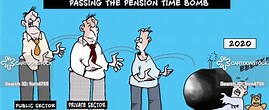Let’s talk about public pension liabilities. This is something important to young and old alike. Why? Because of what is called unfunded liabilities. Almost no one is paying attention to unfunded liabilities in our public pension system.
But it is important because past actions have obligated future dollars for people who will no longer be working for us. Got it? Your taxes are going to go up to pay past pension obligations.
Description of the system
A pension is a guaranteed, lifetime payment to someone after they retire. In the case of public workers that means they have a claim on future tax dollars. Those will be tax dollars not available for schools, healthcare, and other services. Pensions used to be an attractive benefit in the private sector. Every major American company had them. But they became too expensive. As a result companies have taken steps to phase them out.
That is not the case in the public sector. With employees of the government, they’re gobbling up more and more of city and state budgets alive. They are consuming more and more money that could go to tax cuts or better services. Instead, the money is being shoveled aside to pay for these benefits of retired people who do not work for us anymore.
Why is this happening? Well back in the 1990’s the investment returns of our retirement system were more than sufficient to cover present and future outlays of retirees. So our political intelligencia got the bright idea to give the entities which have employees in the retirement system a holiday. They did not require payments to be made into the system. In their world, the stock market would always be good and returns would never go down. They were wrong. They made a mistake.
Whoops! How did we get here?
Well, it ain’t so. Actuarial science says you are going to have good years and you are going to have bad years. In order for the system to remain financially sound you have to keep making payments into the system in good years and bad alike. Over time the good times balance out the bad and the relatively constant level of inputs isn’t egregious as a result. When you stop making payments when returns are good it means you have to raise contribution rates excessively when times are bad. Public pension liabilities isn’t rocket science but it does require discipline and commonsense.
Over the decades, politicians have promised lots of money in pensions to government workers. That includes police, firefighters, teachers, municipal, city and state officials. Name a government job, there’s a pension for that. So, how big are these payments? Many pensions are quite large. In California, more than 62,000 retired public employees are receiving pensions of over $100,000 per year.
Remember, these are guaranteed lifetime yearly payouts. Sure, we love our public employees. They do vital work for our local communities and the wider society. They deserve competitive pay and retirement benefits. But currently, many cities are, in effect, paying for multiple public departments at the same time. We are paying for the department that’s working now and, because people are living longer, a generation or two of retirees. Think about that.
Where are we?
The system amounts to a self-perpetuating, merry-go-round. Public-sector unions give large donations to candidates. The candidates once elected are responsible for negotiating how much of your tax money goes to public sector workers. The arrangements promise high salaries in the short-term. They also hide the payments that will be due down the road when public employees retire. The results are predictable.
State and local governments across the U.S. openly admit to $1.4 trillion dollars of unfunded pension liabilities. That is a staggering $11,000 per household. “Unfunded” means dollars that have been promised, but for which there’s no actual money in the bank. Scarier is that is the amount they admit to. The real number, according to the Federal Reserve, is much larger. They estimate the number at around 4 trillion dollars or $32,000 per household.
So how do politicians get away with this? They use a time-tested political strategy: lying. When they say they can pay for more and more generous pensions, they lie. They are not going to collect more taxes. Oh Hell No, they are going to fund the past obligations by making investments at a “guaranteed” 7.5% return, which is non-sense.
It’s less and less likely they’ll meet their 7.5% goal over time. Their investment behavior, pouring ever more funds into ever riskier investments suggests they know it. If they were to use a more realistic assessment, they need to raise taxes dramatically not for more new programs but for long-retired no longer productive retired employees.
If we want more than a band-aid, what’s the fix?
We can turn the odds in our favor with public pressure, discipline, and common sense. Here’s what needs to happen:
First, we need state and local governments to report unfunded liabilities honestly: the real numbers—using the 2-3% yields that sound financial reporting would require. No more pie-in-the-sky stuff. The truth should shock voters into demanding action.
Second, we must phase out the guaranteed pension programs as quickly as possible and introduce 401K plans. 401K plans, if designed properly, can provide excellent and sustainable retirement benefits. These plans also have the advantage of being portable. If you leave the public sector and go work in the private sector, you get to take your money with you. In other words, you don’t have to be locked-in to a lifetime government job to receive retirement benefits. This should actually be a Win-win.
New Hampshire’s Retirement system in 2011 according to Governing was 57.5% funded. That means we had put away a bit over half of what we needed to do to meet our obligations. By 2018 the legislature had taken some action. The funding had increased to 63.6%. This is still an unacceptable funding level. Is it reasonable to wait another 35 or more years hoping for no recessions to be able to reach an actuarily sound place.
Let’s end the current structure of public sector pensions in New Hampshire. We need to move to a sustainable way of compensating our public workforce. Save your city, your state and your tax money. It is time to bring the retirement system into the 21st century. Public employees have always wanted compensation comparable to the private sector. We know what that requires. It is time to buckle up the chinstrap and get public pension liabilities reform done.

